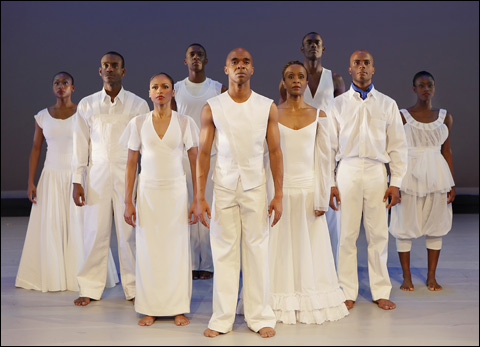
DANCING SPIRIT: Ronald K. Brown’s 2009 piece didn’t trade in the stock Ailey character types and attitudes — until the end. |
George Balanchine didn’t go in for productions of the old classic ballets. He thought them laden with extraneous stage business and local color, and besides, getting the story told could occupy time better spent in dancing. But he’d figured out several ways to gloss the classics by the time he did Coppélia in 1974, and it turned out to be his only full-length remake of a classic for New York City Ballet, apart from The Nutcracker. It must have been the deliciously dancy score by Léo Delibes that drew him to Coppélia, and that score, played in sprightly fashion by Jonathan McPhee and the Boston Ballet Orchestra, sustained the company’s revival at the Opera House.Coppélia has a 130-year history of stellar creators and interpreters, triumphs and tragedies, retentions and deletions. Only a few months after the ballet’s successful premiere performances, in 1870, both its original choreographer, Arthur Saint-Léon, and its 16-year-old star, Giuseppina Bozzacchi, were dead, he of a heart attack and she of smallpox. The Paris Opera closed down because of the Franco-Prussian War. Coppélia was revived when the theater reopened a year later, but according to ballet historian Ivor Guest, the era of Romantic ballet had come to an end.
Rechoreographed by Marius Petipa, Coppélia lived for decades as a transplant in the repertory of the Imperial Ballet in St. Petersburg. For the first time, a male dancer took the role of Frantz, which in the French tradition had been played by a woman en travesti. From Russia, it was repatriated to Europe, the UK, and America. Balanchine collaborated on Coppélia with one of the all-time great Swanildas, Alexandra Danilova, his lifelong close associate and fellow student at the Mariinsky Theater in the early 20th century.
The reason the ballet isn’t named after its leading character is that the plot revolves around a mechanical doll, Coppélia, who does nothing but causes abundant misunderstandings and mischief. Swanilda, a clever village girl, decides to find out about the glamorous stranger who seems to have stolen the affections of her boyfriend Frantz. With her scaredy-cat friends in tow, she sneaks into Coppélia’s house and quickly discovers that beneath her pretty pink dress lies a soul of cotton batting. Dressing up in the doll’s clothes, Swanilda tricks the toymaker, Dr. Coppélius, into thinking he can bring his manikin to life. Frantz realizes his mistake and marries Swanilda in the third act.
Sometimes dancers bring more than caricature to this silliness, but it can’t be easy. I thought Misa Kuranaga, in Boston Ballet’s first cast, was a Swanilda with charm and a quick wit. But her Frantz, Nelson Madrigal, a doltish village type, gave no hint that he cared for her, either before or after the unmasking of Coppélia. The dramatic heart of the ballet was revealed in the second act’s grand-transformation duet between Swanilda and Dr. Coppélius. Boyko Dossev played Coppélius as a youngish, nerdish misfit. As Kuranaga pretended to be changing under his magic hocus-pocus from a wind-up robot to a capricious real girl, Dossev seemed stunned; then he wept when he thought he’d achieved a miracle.